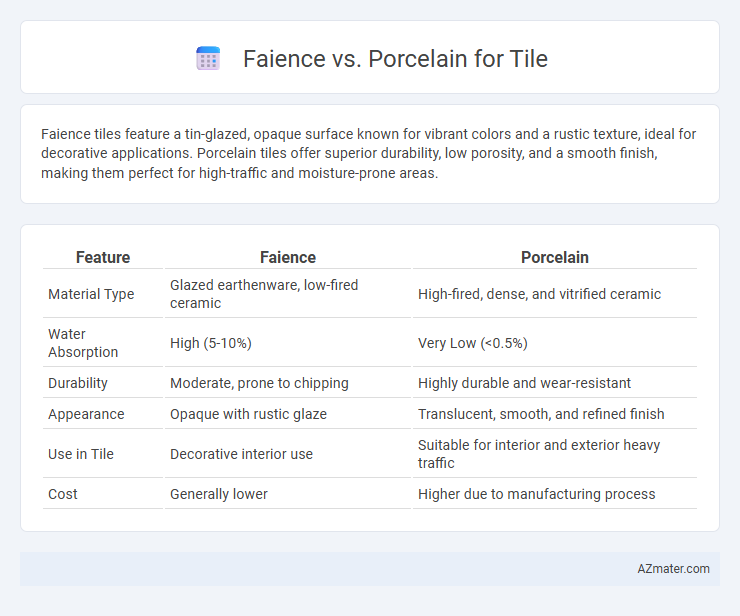Faience tiles feature a tin-glazed, opaque surface known for vibrant colors and a rustic texture, ideal for decorative applications. Porcelain tiles offer superior durability, low porosity, and a smooth finish, making them perfect for high-traffic and moisture-prone areas.
Table of Comparison
| Feature | Faience | Porcelain |
|---|---|---|
| Material Type | Glazed earthenware, low-fired ceramic | High-fired, dense, and vitrified ceramic |
| Water Absorption | High (5-10%) | Very Low (<0.5%) |
| Durability | Moderate, prone to chipping | Highly durable and wear-resistant |
| Appearance | Opaque with rustic glaze | Translucent, smooth, and refined finish |
| Use in Tile | Decorative interior use | Suitable for interior and exterior heavy traffic |
| Cost | Generally lower | Higher due to manufacturing process |
Introduction to Faience and Porcelain Tiles
Faience tiles are glazed ceramic tiles, traditionally made from earthenware clay and characterized by their vibrant colors and glossy finish, making them ideal for decorative wall applications. Porcelain tiles, composed of refined clay and fired at higher temperatures, offer superior density, durability, and water resistance, suitable for both floor and wall installations. Understanding the distinct material compositions and firing processes is crucial when choosing between faience for ornamental purposes and porcelain for high-performance surfaces.
Defining Faience: Composition and Features
Faience is a type of glazed ceramic tile characterized by its earthenware composition, primarily made from clay mixed with sand and other natural materials, fired at lower temperatures than porcelain. Its distinctive glaze provides a glossy, often colorful surface, but the material itself is more porous and less durable than porcelain. These features make faience tiles ideal for decorative applications where aesthetic appeal is prioritized over high durability and water resistance.
What is Porcelain Tile? Key Characteristics
Porcelain tile is a dense, durable ceramic made from refined clay fired at high temperatures, resulting in low porosity and exceptional strength. Key characteristics of porcelain tile include water resistance, high wear resistance, and a smooth, often glossy surface that can mimic natural stone or wood. These qualities make porcelain tile ideal for high-traffic areas and environments exposed to moisture, such as bathrooms and kitchens.
Aesthetic Differences: Faience vs Porcelain
Faience tiles showcase a glossy, vibrant finish with intricate hand-painted designs, emphasizing a rich, artisanal aesthetic ideal for decorative wall applications. Porcelain tiles offer a sleek, uniform appearance with higher density and a subtle variation in texture, suited for contemporary and minimalist design schemes. The distinct surface qualities of faience's glazed, colorful patterns contrast sharply with porcelain's matte or polished finishes, influencing both visual impact and style preferences in interior spaces.
Durability and Strength Comparison
Faience tiles, made from glazed earthenware, offer moderate durability suited for low-traffic areas but are more prone to chipping and wear compared to porcelain. Porcelain tiles, composed of denser, finely-grained clay fired at higher temperatures, provide superior strength, resistance to scratches, and greater longevity. The hardness rating of porcelain on the Mohs scale typically ranges between 6 and 7, making it ideal for high-traffic or outdoor installations, whereas faience generally ranks lower, reflecting its more delicate nature.
Water Absorption and Stain Resistance
Faience tiles exhibit higher water absorption rates, typically ranging from 5% to 20%, making them more prone to moisture-related damage and staining, whereas porcelain tiles boast water absorption below 0.5%, offering superior resistance to water infiltration and stains. The low porosity of porcelain enhances its durability in wet environments, ensuring long-lasting stain resistance and minimal maintenance requirements. Faience's porous surface necessitates more frequent sealing to prevent staining, while porcelain tiles remain resilient without additional treatments.
Maintenance and Cleaning Requirements
Faience tiles require gentle cleaning methods using non-abrasive, pH-neutral cleaners to preserve their porous glaze, as harsh chemicals can cause damage or discoloration. Porcelain tiles offer superior resistance to stains and scratches due to their dense, vitrified composition, making routine cleaning with mild detergents and water sufficient for maintenance. Regular sealing is recommended for faience to maintain its longevity, while porcelain typically does not need sealing, reducing overall maintenance effort.
Cost Analysis: Faience vs Porcelain
Faience tiles generally cost less than porcelain tiles due to lower manufacturing expenses and simpler glazing processes. Porcelain tiles offer greater durability and lower maintenance, which can reduce long-term costs despite a higher upfront price. Evaluating total cost of ownership, including installation and lifespan, often reveals porcelain as the more cost-effective option for high-traffic areas.
Best Applications for Each Tile Type
Faience tiles, known for their glazed, vibrant surface and porous body, excel in decorative wall applications and low-traffic areas due to their delicate nature and aesthetic appeal. Porcelain tiles, characterized by their dense, durable composition and low water absorption, are ideal for high-traffic floors, outdoor spaces, and wet environments like bathrooms and kitchens. Selecting between faience and porcelain hinges on balancing decorative goals with durability requirements for specific residential or commercial settings.
Choosing the Right Tile: Factors to Consider
When choosing between faience and porcelain tiles, consider durability, water absorption, and intended use; porcelain offers superior strength and low porosity, making it ideal for high-traffic and moisture-prone areas. Faience tiles provide vibrant glazes and aesthetic appeal but are more porous and better suited for decorative or low-moisture environments. Assessing the tile's technical specifications alongside design goals ensures optimal performance and longevity in your space.

Infographic: Faience vs Porcelain for Tile
 azmater.com
azmater.com